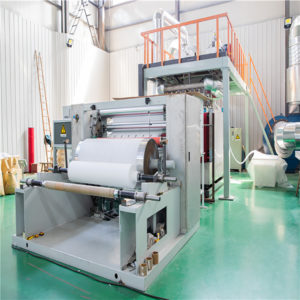The properties of melt blown fabrics can be adjusted by varying the process parameters during the manufacturing process.
Here are some ways the properties of melt blown fabrics can be adjusted:
Polymer type: The type of polymer used to make the melt blown fabric can affect its properties, such as its strength, flexibility, and heat resistance. Different polymers can be used, such as polypropylene, polyester, or nylon.
Melt temperature: The melt temperature of the polymer can affect the size and shape of the microfibers, as well as their orientation and distribution within the fabric. Higher melt temperatures can produce finer fibers, while lower melt temperatures can produce thicker fibers.
Air pressure: The air pressure used to blow the microfibers onto the conveyor belt can affect the porosity, permeability, and filtration efficiency of the melt blown fabric. Higher air pressures can produce denser fabrics with better filtration properties, while lower air pressures can produce lighter fabrics with lower filtration efficiency.
Collector speed: The speed of the collector can affect the thickness and uniformity of the melt blown fabric. Higher collector speeds can produce thinner fabrics with a more uniform thickness, while lower collector speeds can produce thicker fabrics with a less uniform thickness.
Electrostatic charge: Electrostatic charge can be added to the melt blown fabric to improve its filtration efficiency. This can be done by adding an electrostatic field to the blowing process or by treating the fabric with an electrostatic discharge process.
By adjusting these process parameters, manufacturers can produce melt blown fabrics with different properties and performance characteristics to meet the needs of different applications. It is important to carefully control and monitor the process to ensure consistent quality and performance of the melt blown fabric.
How can the filtration efficiency of melt blown fabrics be measured?
The filtration efficiency of melt blown fabrics can be measured using a variety of test methods.
Here are some common test methods used to measure the filtration efficiency of melt blown fabrics:
Particle filtration efficiency (PFE): The PFE test measures the ability of the melt blown fabric to filter out particles of a specific size. The melt blown fabric is challenged with a known concentration of particles of a specific size, and the percentage of particles that are filtered out is measured.
Bacterial filtration efficiency (BFE): The BFE test measures the ability of the melt blown fabric to filter out bacteria. The bacteria used in the test are typically Staphylococcus aureus or Escherichia coli, and the percentage of bacteria that are filtered out is measured.
Viral filtration efficiency (VFE): The VFE test measures the ability of the melt blown fabric to filter out viruses. The virus used in the test is typically bacteriophage MS2, and the percentage of viruses that are filtered out is measured.
Aerosol filtration efficiency (AFE): The AFE test measures the ability of the melt blown fabric to filter out aerosol particles of a specific size. The melt blown fabric is challenged with an aerosol of known size and concentration, and the percentage of particles that are filtered out is measured.
Pressure drop: The pressure drop test measures the resistance of the melt blown fabric to airflow. The pressure drop across the fabric is measured at a specific airflow rate, and a lower pressure drop indicates better air permeability and lower breathing resistance.
By measuring the filtration efficiency of melt blown fabrics using these test methods, manufacturers can ensure that their products meet the required standards and specifications for different applications, such as face masks, air filters, and vacuum bags.

